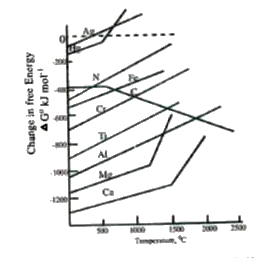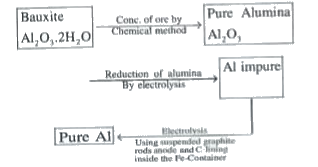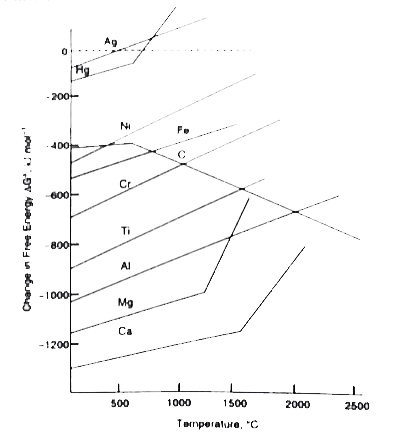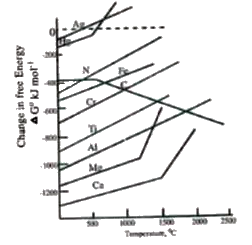For a spontaneous reaction, the free energy change must be negative. ΔG=ΔH−TΔS is the enthalpy change during the reaction. T is absolute temperature, and AS is the change in entropy during the reaction. Consider a reaction such as the formation ofan oxide .
M+O2MO
Dloxygen is used wp in the course of this reaction. Gases have a more random structure (less ordered) than liquid or solids consequently gases have a higher entropy than liquids and solids, in this reaction (entropy or randomness) decreases, hence is negative. Thus, the temperature is raised the ΔS becomes more negative. Since, TΔS is subtracted in the equation, then SG becomes less negative. Thus, the free energy changes increases with the increase in temperature.
The free energy changes that occur when one mole of common reactant in this case dioxygen) is we may e plotted graphically against temperature for a number of reactions of metals to their oxides. The following plot is called an Ellingham diagram for metal oxide. Understanding of Ellingham diagram is extremely important for the efficient extraction of metals.

As per the Ellingham diagram of oxides which of the following conclusion is true?Solution in Telugu
Al reduces Fe2O2 whereas MgO cannot be reduced by Al at 1500∘C
Fe reduce Al2O3, whereas MgO cannot be reduced by Al at 1500∘C
Al reduce Fe2O3 whereas MgO cannot be reduced by Al at 1500∘C
Al can reduce both Fe2O3andMgo to be corresponding metal at 1500∘C
The correct Answer is:A
A metal below in the diagram reduces metal oxide to metal. Which is present above it.
Topper's Solved these Questions
- METALLURGYBook:AAKASH SERIESChapter:METALLURGYExercise:LEVEL-II (LECTRURE SHEET) (EXERCISE-II) (PASSAGE-III)
Explore 4 Videos
- METALLURGYBook:AAKASH SERIESChapter:METALLURGYExercise:LEVEL-II (LECTRURE SHEET) (EXERCISE-II) (PASSAGE-IV)
Explore 4 Videos
- METALLURGYBook:AAKASH SERIESChapter:METALLURGYExercise:LEVEL-II (LECTRURE SHEET) (EXERCISE-II) (PASSAGE-I)
Explore 5 Videos
- IONIC EQUILLIBRIUMBook:AAKASH SERIESChapter:IONIC EQUILLIBRIUMExercise:ADDITIONAL PRACTICE EXERCISE (PRACTICE SHEET ( ADVANCED))
Explore 11 Videos
- NITROGEN CONTAINING COMPOUNDSBook:AAKASH SERIESChapter:NITROGEN CONTAINING COMPOUNDSExercise:Conversions
Explore 18 Videos
Similar Questions
Extraction of Aluminiunt can be understood by :

Electrolytic reduction of Al2O3:
Electrolyte:(Al2O3+Cryolite)Cathode:Graphite inside the Fe containerAnode:Graphite rods
The purpose of adding cryolite is
View SolutionThe heating process for the extraction of elements are quite old but highly acceptable method for the extraction of elements. Become in this process the elements produced is in the highly pure state. Mostly As,Sb,Ni,Zr,B etc are prepared by this principle 4 mumber of metal sulphides which may be reated first in air to partially convert them to the aride, and then further roasted in the absence of air, wing self reduction.
How does impure Ni is purified
View SolutionElectrolysis is an important technique for extraction of metals and each low of the solution needs a minimum voltage to get discharged and this value is expressed in terms of discharge potential. For some metal ions the discharge potentials follow the order give below :
Li+>K+>Ca2+>Na+>Mg2+>Al3+>Zn2+>Fe2+>Ni2+>H3O+>Cu2+>Hg2+2>Ag+>Au3+ For some anions the discharge potentials are in the order:
SO2−4>NO−3>OH−>Br−>I−
When aqueous solution of cuprous bromide is electrolysed the product obtained a cathode will be
View SolutionA solution contains 0.05M of each of NaCl and Na2,CrO4,. Solid AgNO3, is gradually added to it. Whichof the following facts true
(Given: Ksp(AgCl)=1.7×106(−10)M2 and Ksp(Ag2,CrO4,)=1.9×10−12M3:
View SolutionEthanamine to methanamine
View SolutionIn a reaction P+Q→R+S, there is no change in entropy, Enthalpy change for the reaction (ΔH) is 12 kJ mol−1. Under what conditions, reaction will have negative value of free energy change?
View SolutionFor a sponaneous reaction, the free energy change must be negative, ΔG=ΔH−TΔS,ΔH is the enthalpy change during the reaction. T is the absolute temperature, and ΔS is the change in entropy during the reaction. Consider a reaction such as the formation of an oxide
M+O2→MO
Dioxygen is used up in the course of this reaction. Gases have a more random structure (less ordered) than liquid or solids. Consequently gases have a higher entropy than liquids and solids. In this reaction S (entropy or randomness) decreases, hence ΔS is negative. Thus, if the temperature is raised then TΔS becomes more negative,Since, TΔS is substracted in the equation, then ΔG becomes less negative. Thus, the free energy change increases with the increase in temperature.
The free energy changes that occur when one mole of common reactant (in this case dioxygen) is used may be plotted graphically aginst temperature for a number of reactions of metals to their oxides. The following plot is called an Ellingham diagram for metal oxide. Understanding of Ellingham diagram is extremely important for the efficient extraction of metals.

For the conversion of Ca(s) to Ca(s) which of the following represent the ΔG vs. T ?
View SolutionFor a chemical reaction, the free energy change (DeltaG) is negative. The reaction is
View SolutionFor a sponaneous reaction, the free energy change must be negative, ΔG=ΔH−TΔS,ΔH is the enthalpy change during the reaction. T is the absolute temperature, and ΔS is the change in entropy during the reaction. Consider a reaction such as the formation of an oxide
M+O2→MO
Dioxygen is used up in the course of this reaction. Gases have a more random structure (less ordered) than liquid or solids. Consequently gases have a higher entropy than liquids and solids. In this reaction S (entropy or randomness) decreases, hence ΔS is negative. Thus, if the temperature is raised then TΔS becomes more negative,Since, TΔS is substracted in the equation, then ΔG becomes less negative. Thus, the free energy change increases with the increase in temperature.
The free energy changes that occur when one mole of common reactant (in this case dioxygen) is used may be plotted graphically aginst temperature for a number of reactions of metals to their oxides. The following plot is called an Ellingham diagram for metal oxide. Understanding of Ellingham diagram is extremely important for the efficient extraction of metals.

For the conversion of Ca(s) to Ca(s) which of the following represent the ΔG vs. T ?
View SolutionFor a sponaneous reaction, the free energy change must be negative, Delta G=Delta H-T Delta S, Delta H is the enthalpy change during the reaction. T is the absolute temperature, and Delta S is the change in entropy during the reaction. Consider a reaction such as the formation of an oxide M+O_(2) to MO Dioxygen is used up in the course of this reaction. Gases have a more random structure (less ordered) than liquid or solids. Consequently gases have a higher entropy than liquids and solids. In this reaction S (entropy or randomness) decreases, hence Delta S is negative. Thus, if the temperature is raised then T Delta S becomes more negative,Since, TDelta S is substracted in the equation, then Delta G becomes less negative. Thus, the free energy change increases with the increase in temperature. The free energy changes that occur when one mole of common reactant (in this case dioxygen) is used may be plotted graphically aginst temperature for a number of reactions of metals to their oxides. The following plot is called an Ellingham diagram for metal oxide. Understanding of Ellingham diagram is extremely important for the efficient extraction of metals. Free energy change of Hg and Mg for the convertion to oxides the slpe of Delta G vsT has been changed above the boiling points of the given metal because :
View SolutionFor a sponaneous reaction, the free energy change must be negative, Delta G=Delta H-T Delta S, Delta H is the enthalpy change during the reaction. T is the absolute temperature, and Delta S is the change in entropy during the reaction. Consider a reaction such as the formation of an oxide M+O_(2) to MO Dioxygen is used up in the course of this reaction. Gases have a more random structure (less ordered) than liquid or solids. Consequently gases have a higher entropy than liquids and solids. In this reaction S (entropy or randomness) decreases, hence Delta S is negative. Thus, if the temperature is raised then T Delta S becomes more negative,Since, TDelta S is substracted in the equation, then Delta G becomes less negative. Thus, the free energy change increases with the increase in temperature. The free energy changes that occur when one mole of common reactant (in this case dioxygen) is used may be plotted graphically aginst temperature for a number of reactions of metals to their oxides. The following plot is called an Ellingham diagram for metal oxide. Understanding of Ellingham diagram is extremely important for the efficient extraction of metals. Which of the following elements can be prepared by heating the oxide above 400^(@)C ?
View SolutionFor a sponaneous reaction, the free energy change must be negative, Delta G=Delta H-T Delta S, Delta H is the enthalpy change during the reaction. T is the absolute temperature, and Delta S is the change in entropy during the reaction. Consider a reaction such as the formation of an oxide M+O_(2) to MO Dioxygen is used up in the course of this reaction. Gases have a more random structure (less ordered) than liquid or solids. Consequently gases have a higher entropy than liquids and solids. In this reaction S (entropy or randomness) decreases, hence Delta S is negative. Thus, if the temperature is raised then T Delta S becomes more negative,Since, TDelta S is substracted in the equation, then Delta G becomes less negative. Thus, the free energy change increases with the increase in temperature. The free energy changes that occur when one mole of common reactant (in this case dioxygen) is used may be plotted graphically aginst temperature for a number of reactions of metals to their oxides. The following plot is called an Ellingham diagram for metal oxide. Understanding of Ellingham diagram is extremely important for the efficient extraction of metals. As per the Ellingham diagram of oxides which of the following conclusion is true ?
View SolutionFor a spontaneous reaction, the free energy change must be negative. DeltaG=DeltaH-TDelaS is the enthalpy change during the reaction. T is absolute temperature, and AS is the change in entropy during the reaction. Consider a reaction such as the formation ofan oxide . M+O_(2) MO Dloxygen is used wp in the course of this reaction. Gases have a more random structure (less ordered) than liquid or solids consequently gases have a higher entropy than liquids and solids, in this reaction (entropy or randomness) decreases, hence is negative. Thus, the temperature is raised the DeltaS becomes more negative. Since, TDeltaS is subtracted in the equation, then SG becomes less negative. Thus, the free energy changes increases with the increase in temperature. The free energy changes that occur when one mole of common reactant in this case dioxygen) is we may e plotted graphically against temperature for a number of reactions of metals to their oxides. The following plot is called an Ellingham diagram for metal oxide. Understanding of Ellingham diagram is extremely important for the efficient extraction of metals. For the conversion of Ca(s) to CaO(s) which of the following represent the DeltaG vs T :
View SolutionFor a spontaneous reaction, the free energy change must be negative. ΔG=ΔH−TΔS is the enthalpy change during the reaction. T is absolute temperature, and AS is the change in entropy during the reaction. Consider a reaction such as the formation ofan oxide .
M+O2MO
Dloxygen is used wp in the course of this reaction. Gases have a more random structure (less ordered) than liquid or solids consequently gases have a higher entropy than liquids and solids, in this reaction (entropy or randomness) decreases, hence is negative. Thus, the temperature is raised the ΔS becomes more negative. Since, TΔS is subtracted in the equation, then SG becomes less negative. Thus, the free energy changes increases with the increase in temperature.
The free energy changes that occur when one mole of common reactant in this case dioxygen) is we may e plotted graphically against temperature for a number of reactions of metals to their oxides. The following plot is called an Ellingham diagram for metal oxide. Understanding of Ellingham diagram is extremely important for the efficient extraction of metals.

Free energy change of Hg and Mg for the convertion to oxides the slope of ΔG. T has been changed above the boiling points of the given metal because
View SolutionFor a spontaneous reaction, the free energy change must be negative. DeltaG=DeltaH-TDeltaS is the enthalpy change during the reaction. T is absolute temperature, and AS is the change in entropy during the reaction. Consider a reaction such as the formation ofan oxide . M+O_(2) MO Dloxygen is used wp in the course of this reaction. Gases have a more random structure (less ordered) than liquid or solids consequently gases have a higher entropy than liquids and solids, in this reaction (entropy or randomness) decreases, hence is negative. Thus, the temperature is raised the DeltaS becomes more negative. Since, TDeltaS is subtracted in the equation, then SG becomes less negative. Thus, the free energy changes increases with the increase in temperature. The free energy changes that occur when one mole of common reactant in this case dioxygen) is we may e plotted graphically against temperature for a number of reactions of metals to their oxides. The following plot is called an Ellingham diagram for metal oxide. Understanding of Ellingham diagram is extremely important for the efficient extraction of metals. Which of the following elements can be prepared by heating the oxide above 400^(@)C ?
View Solution

